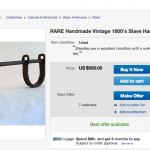It is apparent from this blog thread that concerns about the way history accumulates[1] and continues to vivify the present are of great importance to the study and engagement of the Black Atlantic. The past is not something left behind in some progressive march of history, nor is it a nostalgia that obscures the present with uncritical adoration of a past age. Navigating between these two streams seems to be the difficult, and perhaps even dangerous, work of those interested in the Black Atlantic. There seems to be in pop-history a narration of the Black Atlantic as a progressive march from the low point of enslavement towards this liberated present that has somehow left behind the problems of the past. In this way, engagement of the spiritual in the Black Atlantic can provide a significant voice that interrupts certain dominant narratives, and draws together the past and present in a movement more reminiscent of a dance than an upward march. This is not a dance just for the sake of dancing either, but it allows for the continued protest to the violence and destruction of enslavement, and an interruption of the continuing grammar of racial and class divides so embedded in the experience of the Black Atlantic.
The challenge with approaching the spiritual in this way is how to do so without reducing it to merely a tool of the historian. It is necessary to move into a more concrete situation to avoid such an abstraction. Thus it may be helpful to draw upon the Haitian musical group Boukman Eksperyans. “Drawing upon traditional vodou rhythms, compas, rock, and R & B to create the Haitian Musical movement dubbed mizik rasin (root music)”[2] the band has maintained its bold message of hope and survival throughout the political turmoil of the 1980-90’s and continuing in the post-earthquake challenges of Haiti. Boukman Eksperyans has “let their music be shaped by vodou”[3] both in content and style. The spiritual—which is not to be read as non-political or disembodied—enables this group to engage the complexity of Haiti’s past and present, which is bound with their own experiences. As their bio states, “For all its celebratory color on stage, the Boukman Eksperyans’ message is serious and spiritual. The band’s songs have long served as rallying cries against all manner of ills imposed upon the Haitian people.”[4]
The band’s name in and of itself is a clear message, connecting to the slave revolt of 1791, which sparked the revolution, to their experience today. Boukman was considered to be the one who presided over the religious ceremony of Bwa Kyimon (Bois Caiman) that began the revolt, and he continued as a leader of the revolt; though he was killed early on.[5]
The Band’s choice of the name Boukman Eksperyans has been interpreted as the continuation of the work of Boukman as they use their spiritually laden music to “spark real change in Haiti.” For the band, this work has included encouraging uprisings against the Baby Doc Duvalier regime at great risk to themselves, and encouraging protests in 1991 with the lyrics of their song ‘my heart will not bleed [skip]’[6] (ke m’ pa sote).
https://www.youtube.com/watch?v=FBN2z0mgALk
The music of Boukman Eksperyans embodies the complex space of the spiritual that animates the survival, hope and resistance of the Haitian people, which is the story of the history of Haiti. Groups such as Boukman Eksperyans, with their explicit invocation of the past as revivified in the present provide a space to engage the accumulating history of the Black Atlantic. Furthermore, their seamless connection of the spiritual and the political enables the listener/participant to avoid a potential false dichotomy. Significantly, this work is constructive, bringing together fragments of the history of Haiti, and the Black Atlantic more broadly, to engage in the possibilities of life that emerges.
[1] For this I believe our blog is indebted to: Ian Baucom. Specters of the Atlantic: Finance Capital, Slavery, and the Philosophy of History. Durham: Duke University Press, 2005.
[2] RVANews Staff, Sept. 9, 2010. http://rvanews.com/z_legacy/folk-festival/2010/bios-2010/bios-main-stage/boukman-eksperyans.
[4] Boukman Esperyans Professional Bio on RVANews. http://rvanews.com/z_legacy/folk-festival/2010/bios-2010/bios-main-stage/boukman-eksperyans
[5] Laurent Dubois. Avengers of the New World: The Story of the Haitian Revolution. Cambridge, Mass: Belknap Press of Harvard University Press, 2004, pp101-104.


